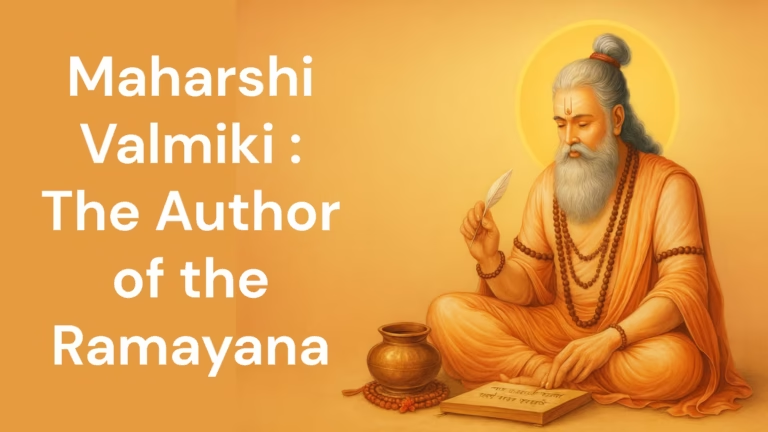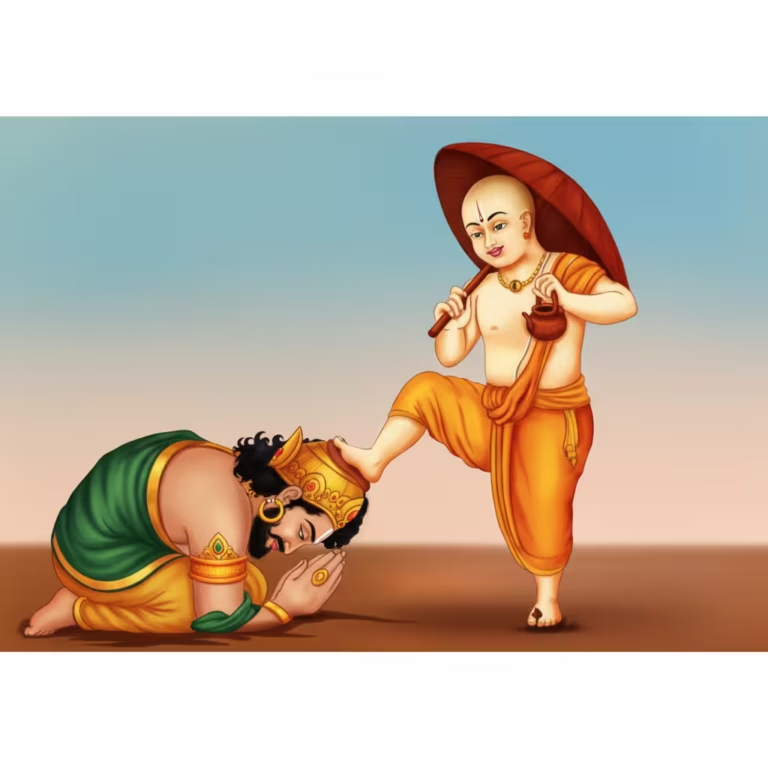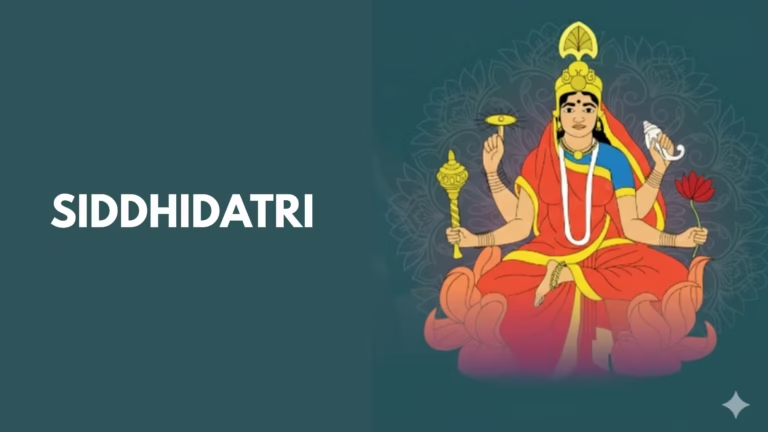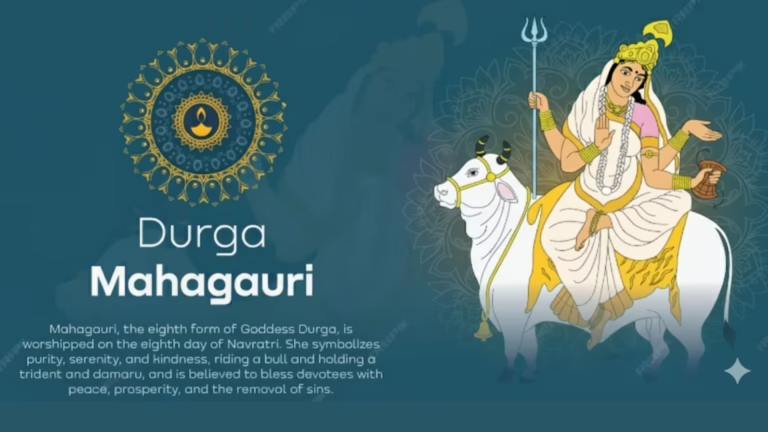As the seventh worshipful dimension in the Navadurga sequence, Maa Kaalratri embodies the fierce manifestation of Shakti—dispelling fear, darkness (tamas), and unrighteous tendencies while awakening courage and discernment within the seeker. The Shakta tradition, as narrated in the Devi‑Mahatmya (in the Markandeya‑Purana lineage) and the Devi‑Bhagavata Purana, describes multiple forms of the Primordial Goddess. Through Her fierce emanations—by which She subdues asuras and restores cosmic order—the philosophical import of Kaalratri becomes clear: fierceness for the destruction of evil; compassion for the protection of devotees.
This Life‑Charit presents a Puranic, text‑grounded view of Kaalratri across the following sections: Etymology, Origin, Iconography, Divine Acts (Lila), Worship (Sadhana) Procedures, Fruit of Practice, Place in the Navadurga Sequence, Dharma‑Ethic, along with Do‑Nots in Puranic Worship, FAQs, and a Practical Takeaway—so that readers receive scripturally aligned, accurate, and actionable understanding in one place.
Etymology and Philosophical Purport
The name “Kaalratri” holds two ideas: Kaal (Time / Sovereign / Bearer of dissolution) and Ratri (Night / Ignorance / Veil). In the Puranic imagination, this form of the Goddess removes the ungoverned fear of time and the veiling darkness of ignorance. Philosophically, Kaalratri signifies the transcendental power that pierces the night of ignorance and fear, opening the gates of fearlessness (abhaya) and discernment (viveka) for the seeker.
Etymology also hints at balance: the conquest of darkness is not by wrath alone but by a harmony of fierceness and stillness—where destruction targets adharmic impulses and protection upholds the path of dharma.
See also: Maa Mahagauri — Life‑Charit (Puranic Perspective)
Origin‑View: The Fierce Dimension of the Goddess
Puranic texts describe the Primordial Shakti as Mahamaya, the cosmic power of the Supreme. In the Devi‑Mahatmya, upon the supplication of the devas, the Goddess manifests fierce forms that vanquish asuric forces. Such destruction is not wanton violence but the re‑balancing of cosmic order. The idea of Kaalratri signals precisely this fierce dimension—the dispeller of tamas—who quells fear, delusion, inertia, and allied asuric tendencies within and without.
The Devi‑Bhagavata Purana similarly expounds the Goddess’s many forms, their manifestations, and systems of worship. Seen through this lens, Kaalratri embodies a core function of Shakti: to pierce the veil (avarana‑bhedana)—dissolving the night of ignorance and ushering the dawn of dharma‑light.
Iconography: Weapons, Vehicle, and Emblems
Puranic hymns and devotional poetry portray Kaalratri as fierce, radiant, and tamas‑transforming. Major traits preserved in tradition include:
- Complexion: deep dark / black‑blue—signifying the power that strikes the sheath of ignorance.
- Hair and Face: sometimes disheveled locks, sometimes a severe radiance—a symbol of the poised balance between fierceness and compassion.
- Arms and Mudras: textual and artistic traditions vary in arm‑count and weapons; commonly, Varada (boon‑bestowing) and Abhaya (fear‑dispelling) mudras appear with weapons like khadga (sword), trishula (trident), or vajra (thunderbolt).
- Vehicle: in Navadurga iconography She is often shown on a donkey (garda / gardabha)—emblematic of unwavering toil, humility, and fearless steadiness.
- Aura / Radiance: a fierce brilliance that dispels darkness in all directions—metaphor for the inner light of discrimination.
Note: Weapon‑lists, arm‑counts, and subtleties vary across texts and hymn‑traditions. The scriptural intent is to convey functional aspects (protection and dissolution), not a rigid numeric fixation.
Divine Acts (Lila): Dispersing Darkness and Establishing Dharma
In the narrative arc of the Devi‑Mahatmya, fierce emanations of the Goddess—invoked by the devas in distress—subdue asuric hosts. Episodes concerning Shumbha‑Nishumbha, Chanda‑Munda, and Raktabija symbolize the operational expressions of fierce Shakti. The construct “Kaalratri” provides a philosophical name for this very function: the quelling of inner darkness (ignorance, fear, negligence) and the correction of outer unrighteousness.
These wars, while narrated as external battles, are also allegories for inner sadhana—the conquest of one’s own distortions by divine strength and clarity. The aim of Kaalratri‑worship is to understand “fierceness” not as anger, but as disciplined justice within self‑control.
Worship (Sadhana) — Scriptural Basis
The foundations of Shakta sadhana are mantra, meditation, hymnody, and ethical purity in conduct. In many traditions, Kaalratri is worshipped on the seventh day of Navadurga; minor differences in day‑order and procedures may appear across lineages. Core priorities include:
- Purity and Resolve: truthfulness, non‑violence, self‑restraint, and sattvic diet; purity in mind, speech, and action makes worship meaningful.
- Textual Recitation: Devi‑Mahatmya (Durga‑Saptashati lineage), Shakta stotras, and guru‑given mantra‑japa—strictly as per teacher’s guidance.
- Meditation: contemplate the fierce form with the resolve to dispel inner darkness; remember Her Abhaya/Varada gestures as the spirit of fear‑removal and grace.
- Invocation, Offerings, Lamp‑worship: all within scriptural decorum; inner cleanliness over outer ostentation.
The Puranic current insists that the real core of worship is purity of conduct; externals bear fruit only when inner practice is steady.
Fruit of Practice (Sadhana‑Phala)
The Puranic understanding of Kaalratri‑worship emphasizes inner fearlessness and the illumination of discernment. Principal fruits noted in the tradition include:
- Removal of Fear: dissipation of anxiety, doubt, and the darkness of tamas; emergence of abiding fearlessness.
- Patience and Self‑control: stability under adversity; transmuting fierceness into ethical justice rather than anger.
- Energetic Right‑Action: overcoming inertia and negligence; cultivating sattvic effort and wise time‑use.
- Obstacle‑Removal: victory over internal and external impediments; continuity and focus in sadhana.
- Public‑spiritedness: a movement beyond personal safety toward social protection and justice.
These fruits stabilize only through regular, text‑aligned, and teacher‑guided practice.
Place of Kaalratri in the Navadurga Sequence
The nine worshipful dimensions of Shakti in Navadurga lead the seeker through progressive states: purity, austerity, valor, creative insight, maternal compassion, heroic strength, dissolution of darkness, radiant purity, and integration of accomplishments. Within this order, Kaalratri—seventh—marks the pivotal node of dispelling darkness and bestowing fearlessness. Day‑order and ritual nuance can vary across lineages, but the integrative intent of Goddess‑principle remains constant.
Dharma‑Ethic: The Balance of Fierceness and Stillness
Kaalratri teaches that the goal of fierceness is resistance to adharma, not performance of rage. Three working sutras:
- Self‑Governance: mastery over impulses; regulation of attachment and violence‑tendencies.
- Justice‑Led Valor: never bowing to fear; valor kept within the bounds of ethical restraint.
- Service to Society: fulfilling familial and social responsibilities; protection of the weak; honoring rightful norms.
Only under such balance does fierce power become a cause of public welfare—this is Kaalratri’s practical counsel.
What Not to Do in Puranic Worship
- Unscriptural Methods: avoid esoteric mantra‑rites/tantric processes without proper initiation and guidance.
- Ostentation: prefer inner cleanliness, truth, and compassion over display and luxury.
- Unwarranted Claims: do not affirm what lacks clear textual grounding; seek scriptural proof first.
Frequently Asked Questions (FAQ)
1) Is Kaalratri mentioned in the Puranas themselves?
Yes. The fierce emanations, asura‑slaying episodes, and restoration of dharma are elaborated in the Devi‑Mahatmya (Markandeya‑Purana lineage); the Devi‑Bhagavata Purana expounds Shakti‑tattva and worship systems in detail. The Navadurga tradition’s “Kaalratri” is a worshipful synthesis of these fierce dimensions.
2) Is the donkey definitively Her vehicle?
In Navadurga iconography the donkey (gardabha) is widely attested. Some poetic/artistic depictions differ. The intended symbol is fearless effort, humility, and steadfast endurance.
3) Are the arm‑count and weapon‑list fixed?
Hymn‑ and image‑traditions vary. The doctrinal burden is functional—the harmonizing of protection and dissolution—not fixation on numbers.
4) Do Puranas mandate specific colors/foods/dates?
Puranas primarily teach principles of practice; color/offerings/day‑orders are often later local customs. Prioritize textual recitation, mantra‑japa, and ethical conduct.
Practical Takeaway: Conquering Fear, Lighting Discernment
Kaalratri instructs that fear is conquered by an inner culture of fearlessness—born of self‑restraint, truth‑observance, and scriptural practice. Sloth and delusion are overcome through wise use of time and steady effort. Fierceness yields welfare only when disciplined by justice and dharma.
Maa Kaalratri is thus the current of Shakti that clears the seeker’s life of darkness, fear, and negligence, establishing courage, patience, and discriminative light. In the Devi‑Mahatmya and Devi‑Bhagavata tradition, the aim of fierce emanations is the removal of adharma and the restoration of dharma—this is the essence of the Kaalratri‑principle. The foundation of worship remains a pure heart, scriptural recitation, and adherence to the teacher’s counsel—from which arise lasting peace, duty‑steadfastness, and meaningful life.



